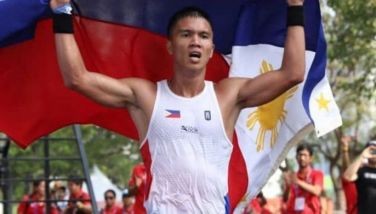Forever the greatest

Carlos (Sonny) Padilla is known as the Filipino referee who worked the “Thrilla In Manila” between Muhammad Ali and Joe Frazier at the Araneta Coliseum on Oct. 1, 1975. That appearance launched a successful career for Padilla who went on to officiate in world title fights involving legends like Sugar Ray Leonard, Roberto Duran, Tommy Hearns, Mike Tyson, Marvelous Marvin Hagler, Larry Holmes, Julio Cesar Chavez and Alexis Arguello up to 2000.
But it’s a little-known fact that Padilla wasn’t the first Filipino to work an Ali fight. In 1973, Ali battled Dutchman Rubi Lubbers in Jakarta with Filipino travel agent Enrique (Jimmy) Jimenez as the third man in the ring.
International promoter and matchmaker Lope (Jun) Sarreal Jr., now 80, coordinated the fight in Jakarta and brought in Jimenez. “Jimmy loved boxing and was always around Bay (Flash Elorde),” said Sarreal. “In 1970, my father (Hall of Famer Papa Sarreal Sr.) chose Jimmy to be the referee in the Masao Ohba fight against Berkrerk Chartvanchai in Tokyo. Jimmy did such a good job that when (co-promoters) Bob Arum and Don King asked who could referee Ali’s fight in Jakarta, his name came up.”
Ali travelled the world not only to promote boxing but also to deliver the message of goodwill, hope, social justice and brotherhood. Sarreal recalled that Ali fought Mac Foster in Tokyo in 1972 and Joe Bugner in Kuala Lumpur in 1975. He also performed in a three-round exhibition in Singapore before proceeding to Manila.
Throughout his career, Ali made a name for himself as the people’s champion. He fought thrice in London and displayed his wares in Toronto, Vancouver, Zurich, Munich, Frankfurt, San Juan in Puerto Rico, Dublin and Kinshasha in the Congo. There was a reason why Ali chose to battle Trevor Berbick in his farewell fight in Nassau, Bahamas, in 1981. For Ali, the whole world was home. Not only Louisville, Kentucky, where he was born. He fought for mankind, for every human being. Ali was a man for all.
At the peak of his boxing career, Ali sacrificed a fortune when he chose to challenge the US military draft in protest of war. The legal battle took him out of the ring for four years until the Supreme Court overturned his conviction.
If there was one fault in Ali, it was his failure to recognize when to retire from the ring. The “Thrilla In Manila” left Ali badly battered and he admitted it was the closest thing to death. But he figured in 10 more fights after that, losing three of his last four outings up to 1981. Three years after he hung up his gloves, Ali was diagnosed with Parkinson’s disease. He fought too many more fights he shouldn’t have. But Ali turned that setback into an inspiring motivation to carry on his mission of promoting global peace and understanding. Despite the debilitating effects of the syndrome, Ali continued to tour the world and in 1996, even lit the Olympic flame at the Atlanta Games even as his hand trembled and his body shook from the tremors of Parkinson’s.
Last Friday, Ali passed away in Phoenix. It was incredible that when his body functions shut down, his heart continued to beat for 30 minutes, symbolic of what drove him to fight the good fight until the end.
Sarreal said his memories of Ali will forever be etched in his consciousness. “Ali’s trainer Angelo Dundee was Papa’s good friend and I remember when they were once in South America, Angelo mentioned he had a young fighter who would someday rule the world,” said Sarreal. “Angelo told Papa the fighter named Cassius Clay would throw five to six combinations when he was taught to throw only two to three. When Ali and Frazier came to Manila, they attended the cornerstone laying of the Elorde complex in Sucat. Ali stayed at the Hilton Hotel and Don King, at the Philippine Plaza. For over a year, I took at least five trips to the US to coordinate the promotion with Don and Bob. The project was guaranteed by PNB and at first, Finance Secretary Cesar Virata didn’t approve it but the First Lady (Mrs. Imelda Marcos) wanted it to happen as the fight would introduce the Philippines as a tourist destination.”
Sarreal said Holmes fought Rodney Bobick in the Ali-Frazier undercard and the fight was nearly cancelled. “We didn’t sleep the night before and we were at the Araneta by 6 a.m. because the main event was scheduled at 10:45 a.m. to be shown live via satellite to the US on prime time,” he continued. “Before Holmes’ fight, Don King told me someone left the boxing gloves at the Philippine Plaza. Luckily, I had spare gloves but they were undersized. Holmes and Bobick wore them anyway. I also recall when Ali fought in Jakarta, the ring they used was a 16 by 16 instead of a 21 by 21. It was too small for heavyweights but the fight went on just the same.”
The “Thrilla In Manila” was a showcase for the Philippines. Pilita Corrales sang the National Anthem and Miss Philippines candidates were the round girls. Joe Cantada, wearing a Barong Tagalog, was the ring announcer. The judges were all Filipinos, Larry Nadayag, Alfredo Quiazon and Padilla. Three referees were brought in as nominees to work the main event – Zach Clayton, Arthur Mercante and Harry Gibbs. But President Marcos instructed GAB chairman Louie Tabuena to pick a Filipino instead and the job went to Padilla.
- Latest
- Trending
































